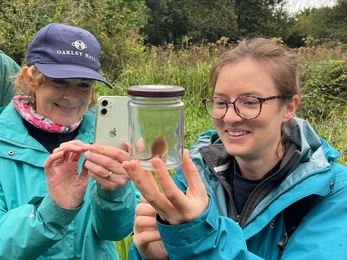The go-to method for surveying small mammals, a ‘Longworth Trap’ consists of a metal cube and a skewed metal tunnel, with a tripwire that snaps the tunnel door shut, trapping its occupant. We’ve stocked 103 of them with straw and a tempting buffet of vegetables, grains, and casters (fly pupae!) and are here the following day, to see what we’ve caught.
We survey two sites: Russell’s Mead and Morris Mead. The first, Russell’s Mead was a tangle of sedge and willow, and presented us with our first occupant.
We remove the tunnel over a plastic bag, and a squirming chestnut body fires out like a rodential cannonball. Tapered nose, satellite-dish ears and a fleshy pink tail identify our guest as a mouse. Due to the size, and lack of Yellow ‘bib’ of the Yellow-Necked Mouse, we can identify them as a Wood Mouse, Apodemus sylvaticus.
The mead produced another Wood Mouse and two Bank Voles, Myodes glareolus. Blunter noses, ears, and generally rounder; sporting a rufous fur coat.
As always though, the best came last. The trap felt light to the touch, and there was a heavy possibility it may have been triggered by marauding slugs. However, upon tilting it, a tiny, suitably named Micromys minutus sprawled into the bag – a Harvest Mouse. Weighing as little as a 2p coin, they resemble a Wood Mouse that’s shrunk in the washing machine.





